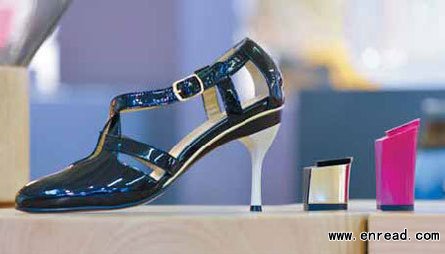| ||||||||||||||||||||||||||||||||||||||||||||||||||||||||||||||||||||||||||||||||||||||||||||||||||||||||||||||||||||||||||||||||||||||||||||||||||||||||||||||||
|
旅居巴黎的加拿大女子坦尼亚•希斯经过三年的研究制作出了一款可随意调换鞋跟高度的高跟鞋。当你走在上班路上,觉得鞋跟太高、脚不舒服的时候,只要按一下鞋跟上的按钮,把高跟卸下来,换上一副适合走路的鞋跟就可以了。
 A multi-height shoe with changeable heels, created by a Canadian-born shoe designer, on display in Paris. Tanya Heath is on a double mission: To prove that women can wear heels(高跟鞋) without ruining their feet, and that a heel that switches from high to low can be made entirely1 in France.
The Paris-based Canadian started with a simple idea. When your shoes start to hurt - halfway2 through a party, a wedding or a workday - press a button in the sole, slot out your dressy high heel and replace it with a walking version.
"I'm a feminine feminist," is how the 42-year-old sums up her philosophy. "My shoe is designed to be sexy - but on the woman's terms."
"You can do your two-hour meeting, and then you just take off your high heel," she explained at the Ethical3 Fashion Show in Paris this month. "You're getting relief - and you're getting home."
So far so good, except the trick - which no one had quite figured out until now - is how to keep the shoe balanced and comfortable both on tip-toe and when you tilt4(倾斜) it back to sit on a low heel.
The fruit of three painstaking5(艰苦的) years of research, Heath's patented answer to the riddle6 is billed as the world's first multi-height heel, a luxury leather shoe that switches seamlessly from 9 to 4 centimeters.
From pastel pink patent sandals to strappy(有带子的) dancing shoes or demure7 lace-ups, with either stiletto or chunky heels, high or low, the shoes are pitched at the high end of the market, starting at around 250 euros ($320).
But while her upscale Tanya Heath line will continue to be made in France, she already has plans for a second brand, which "will have to be made somewhere else".
To meet large orders coming in from South Korea or Canada, she needs to scale up production and bring down her price.
"I would like a real working girl to be able to have them," Heath said. "But it's impossible to make a Made in France affordable8. A skin of leather alone costs 80 euros here. I'm here to tell you it can't be done."
With models harking back to the 1920s, Heath wanted a "deliberately9 nostalgic" style to offset10 the "gee-whizz technology".
"It's an incredible game of geometry," she said. "All shoes, quality ones, follow a set of geometric(几何学的) rules, and always have done. I don't follow those rules. We did things differently."
A passionate11 heel-wearer, Heath's project was born partly of personal experience, having suffered foot deformations12 from heels, like an estimated 38 percent of women around the world. "I had had enough of aching feet, and I refused point-blank to wear ballerina flats," she joked.
But she also wanted to show that shoes could still be made in a high-cost economy like France.
In 1996, Heath left a job as policy analyst13 at the Canadian foreign ministry14 for a new life in Paris, following her oil executive fiance, a "Camembert and champagne15" lover who refused to be based anywhere else.
Once there she learned French at business school and worked in management and high-tech16, then private equity17, all the while raising three young children.
In 2009 she quit her job and threw herself into the heel project, heading to the Dordogne to investigate taking over a struggling shoe factory as a way to kickstart the project.
When she got there Heath was in for a shock. "I saw the factory closed down and 52 people out on the street, the boss locked out - and I thought, 'Whoa!'"
As a liberally trained economist18, she had two ways of reading the situation. "One is that France is non-competitive, and we deserve everything we get because we've killed the industry. And the other way is to say maybe, with an innovation, we can save some jobs here.
"I thought, we'll go for the innovation theory."
The buyout idea came to nothing, but she went on to surround herself with a team of 21 engineers, designers and technicians, in addition to herself and an associate, to bring her concept to life.
The resulting shoe is entirely made in France, with leather from central Limoges. Parts are produced in three French factories in Franche-Comte, Cholet and Rouen.
Her firm is one of around 50 that still make shoes entirely in France. She says running a factory in Rouen - as opposed to China or Vietnam - allows her to choose more quickly.
点击  收听单词发音 收听单词发音
|
||||||||||||||||||||||||||||||||||||||||||||||||||||||||||||||||||||||||||||||||||||||||||||||||||||||||||||||||||||||||||||||||||||||||||||||||||||||||||||||||
上一篇:表现派作品《呐喊》将在纽约展出 下一篇:坠机时尾部位置最安全 |
||||||||||||||||||||||||||||||||||||||||||||||||||||||||||||||||||||||||||||||||||||||||||||||||||||||||||||||||||||||||||||||||||||||||||||||||||||||||||||||||
- 发表评论
-
- 最新评论 进入详细评论页>>



